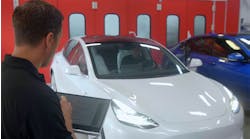Despite his role as a quality assurance reinspector for Safeco, Wayne Griffin still considers himself an “industry guy.”
After owning his own collision repair shop for several years, Griffin is now making the collaboration between shops and insurance companies more cohesive, working with the Nasvhille I-CAR Committee and hosting estimator training classes.
“Wayne is always eager to share his thoughts about the future of our industry,” writes Twila Harris, managing partner for Auto Art Body Shop in Nashville, in her FenderBender Awards nomination for Griffin. “He is always focused on how to improve how we repair vehicles and implementing strategies for success.”
I try to share my I-CAR knowledge with shops on how to do correct repairs. I push them for more education. I’ve gotten quite a few of the shops in my state involved with I-CAR committees. In return, Tennessee had earned the reputation for being a leader in supporting I-CAR training. And that’s not me—it’s all of the volunteers across the state that have enough vision to support the cause.
Many shops are not offering the proper training to their staff and then they wonder why they are having problems keeping up with the industry. On the insurance side of the industry, we have better access to training of all kinds, from customer service to technical repair issues. There seems to be a bigger awareness by the insurance companies on the need for continuous training on all aspects. That’s why I’m motivated to teach these classes, to make estimating better at shops. Doing so will pay off in the long run. It is my goal to share my knowledge and training with everyone in the industry so that we are better prepared to face the many changes that are occurring now and to warn them of the coming changes.
We have a lot of reports on the insurance side. Shops have reports, but they don’t use them as much as we do. When I go into a shop and show them their results compared to goals and the industry averages, why is it they’re surprised? They can get a lot of the same reports that I have, but many won’t run the reports. This is another sign that many are not fully trained or aware of the info that is available to them.
That’s part of the motivation with my training sessions. That’s why I work so closely with all of my writers in the shop who are trying hard to be successful in the industry. I’m training them to recognize and care about all parts of the process, from how to greet the customer to how to document the estimate and file.
My job is to teach these guys how to write a proper estimate, but more importantly, how to document that estimate. Why did you write it the way you did? Why did you write “replace” instead of “repair”? Why did you put eight hours on that quarter panel? I’m looking at the photo and it looks like five to six. But if you put a note on there that says, “Hey, there’s two body lines in here, extra work around the opening or other considerations,” then I understand your reasoning.
I want them to tell me the whole story. Tell us your thought process on how you came to that decision. I heard a manager talking to his staff the other day: “If you guys would listen to Wayne and document the way he’s asking and document the estimates correctly and take the proper photos, every insurance company out there will be happy with you guys.” That’s what I’m trying to train them to do. We have to get their mindset in a different place.
This is how I see my job today: My job is to train the writers to write a fair and complete estimate on each vehicle; to explain their thought process when making decisions about repair versus replace, the times they have for repairs and the selection of parts; to take and label the proper photos that will depict the damages and provide additional information required; to provide excellent customer service to all customers, which includes being a professional and answering all questions from the customer. As I like to tell my shops: ”If you guys would handle all of the claims properly, then I wouldn’t be need any longer. And I told a group yesterday: “So far you guys aren’t doing a very good job at getting rid of me.” Hopefully I can change that.




